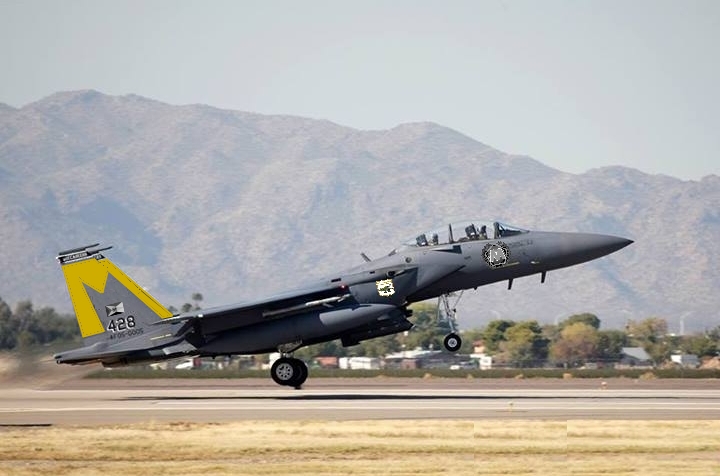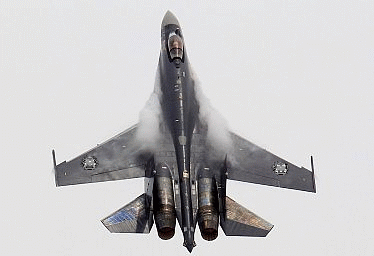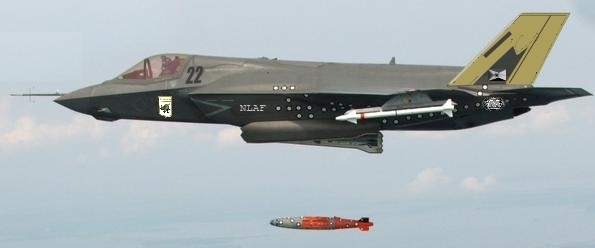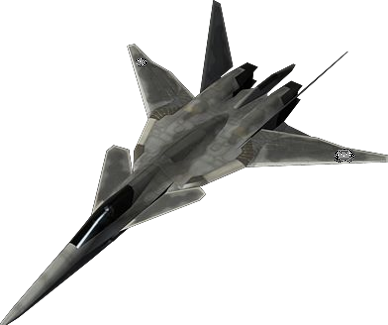2000 till present day
Contemporary Airforce Fighters and Fighter-bombers
McDonnell Douglas F-15A&B
The last day of employment of this iconic fighter in the Newlands Airforce was July 25, 2005. Since the first of twenty-six F-15As arrived in May of 1985, and the initial of twenty-four F-15Bs just three months later, this meant the end of exceptional twenty years of service with not a single plane lost to any cause. Yet, political considerations drove Newlands to become less dependent on arms imported from the USA, and the F-15 had to go, easily sold on world’s weapon markets. During their employment, F-15s were armed with the same avionics, weapons, and weapons systems as in the USAF. They were based in Nordporte and on Ceti III.
Sukhoi Su-27
Newlands Airforce started receiving the supermaneuverable Russian Sukhoi Su-27 Mach 2.35 fighters in 1996 (Newlands Navy started getting its own Su-27s and Su-30M2s in July of 1997), displacing numerous American-made fighters: F-15s, F16s, and F-18s. Marija Black, the 7th President of Newlands, died in 1999 near Washington DC, in the crash of her Boeing 757. For many proponents of conspiracy theories on Newlands and worldwide, these two events are clearly related. They theorize that the Clinton administration couldn’t forgive Newlands this, and some other political “stabs in the back”, and in revenge orchestrated her demise. Marija Black’s death was never solved, but the Su-27s kept arriving until NLAF received hundred operational planes and forty-five training aircraft and the Navy ninety-eight of all models. For defense of the Newlands airspace NLAF Su-27s use weapon systems identical to those used by their Russian counterparts, with minor differences in communication equipment and avionics. As years went by, they were partially displaced by more modern aircraft, but MANATO discovered that the used fighters are in great demand worldwide. By 2010 all training Su-27s were also sold or transferred to the Newlands Navy. In 2020 NLAF still operates forty-two of these majestic birds of prey, about half of them in special drone-interdiction units. They are based all over the archipelago.
Titan TS-37 - Su-47 (S-37 Berkut) Golden Eagle
In Russia, the Mach 2.2 Su-47 (S-37 Berkut) was an experimental fighter, a testbed for other more advanced designs. In 2003 Titan acquired the license for its production, renaming it TS-37 Golden Eagle (direct translation of the word “Berkut”), and transforming it into the main Newlandean defensive fighter. By 2010 fifteen were in service, twenty-eight in 2015, and the final planned number of thirty-nine was achieved in August of 2020. Titan will keep producing spare parts and servicing the fleet into foreseeable future, but its production lines inevitably switched to Rudiuses and Aurelias, the next-generation Labyrinthium super-fighters. Starting with the fighters produced in 2017, KGZ protection has been added to the cockpit, engines, and fuel tanks. This will be retrofitted to all fighters in service. TS-37 is armed with conventional weapons (guns and missiles identical to the armament of Su-27s). It didn’t yet receive modifications enabling it to carry Labyrinthium beam weapons, though the first such conversion is scheduled for 2022. The main differences between the Newlandean TS-37 and the Russian Su-47 are internal; Golden Eagles use fully Newlandean-designed computer system and communication setup, Israeli avionics, advanced domestic weapons control, and more titanium and other advanced alloys in construction of their fuselage, tail, and wing surfaces, permitting operation at higher Gs. All Golden Eagles are based in Nordporte and will remain in service at least until 2035.
Lockheed Martin F-35 Lightning II
Prompted by President Li Lian in 2007, to appease the Americans and acquire a western-built STEALTH fighter, MANATO ordered an even dozen of F-35A, F-35B STOVL, and F-35C fighter-bombers for the Newlands Airforce. All these planes were delivered between 2010 and 2015, making Newlands the first country outside of the United States to receive and operate them. Their employment was restricted by the Americans until design problems got resolved; however, on Newlands, Titan heavily redesigned many of their systems, ending with an airplane only superficially resembling its worldwide cousins. Therefore, those restrictions weren’t observed. F-35As replaced the last aging Mirage F1 fighters and are employed exclusively as fighter-bombers. Newlandean F-35As are armed with the original American weapons systems and won’t be receiving the Labyrinthium beam weapons. In a rare, never attempted cooperation between the Airforce and the Navy, NLAF Lightning IIs operate from terrestrial Airforce bases on Ceti I and II and from all Newlands Navy aircraft carriers.
Sukhoi Su-57 PAK T50
NLAF received its first two STEALTH PAK T50s fifth generation air superiority fighters in 2011 and for several years these were all the planes delivered. Deliveries resumed in 2018 and are scheduled to reach the complement of forty planes by 2028. Su-57s are scheduled to replace their predecessors, Su-27s, as the defenders of the Archipelago. They will all be based on Ceti III.
Titan TS-27 Aurelia
Aurelia is the single-seat Mach 6 swing-wing air superiority active-plasma STEALTH high altitude and space fighter, the pinnacle of Titan’s military and space programs, without any parallel in the world. The Aurelia program originated as a Soviet design of a Mach 3 conventional high-altitude fighter to contend with the American SR-71 spy planes. As SR-71 was withdrawn from service, the high-altitude program got shelved. In 1992 Titan purchased these shelved plans from Russia. There was a caveat, though. If Titan succeeds in engineering that fighter plane, twenty of them would be exported to Russia. This deal was unprecedented as no high-tech Newlandean military design was ever exported outside of the archipelago. Titan’s designers, engineers, and scientists steadily improved the Russian project. In 2002 the name Aurelia was chosen. By 2007, the Labyrinthium drive was successfully mated with Aurelia’s fuselage and it was obvious that the new fighter would be able to operate in space as well. From then on, improvements in its hermetically sealed cockpit and the amount of oxygen and other pilot support that it can carry, the only limiting factor to the length of time it can spend in space, were introduced. Early on the Aurelia program branched, into the Newlandean and Russian Aurelias.
The Newlandean Aurelias are Mach 6 high altitude and space fighters, powered by Russian-built conventional engines with limited ramjet capability and the Labyrinthium drive, armed only with Labyrinthium beam weapons. The first Newlandean Aurelia was delivered to NLAF in 2009, and since then the average of two were added every year. Aurelia suffered an important setback in 2011 when the impurities in locally mined titanium caused a midair explosion of its Labyrinthium drive, with total destruction of the plane. The pilot survived. This problem necessitated reengining of almost all existing planes and caused an eighteen-month delay. Aurelias, almost completely secret, got revealed to the outside world when two of them successfully battled the 2012 Mt Root eruption, saving the town of Corintian from utter destruction. In 2015, Aurelias were accepted into full service, based in Nordporte and Ceti III’s Cosmodrome. In 2020, NLAF possesses twenty-two operational Aurelia space fighters.
The Russian Aurelias are conventionally powered Mach 3.5 high altitude fighters, armed with missiles, and with 100% Russian engines and equipment. Early in development of the model earmarked for Russia it was recognized that the plane will be much more potent than previewed, and the contract between Newlands and Russia was renegotiated. Under the terms of the new contract, Newlands will deliver twenty Aurelias to Russia by 2028, while Russia will at the same time provide NLAF with forty Sukhoi Su-57 PAK T50. The first Russian Aurelia was delivered in 2013, with ten planes in all delivered by December of 2020.





